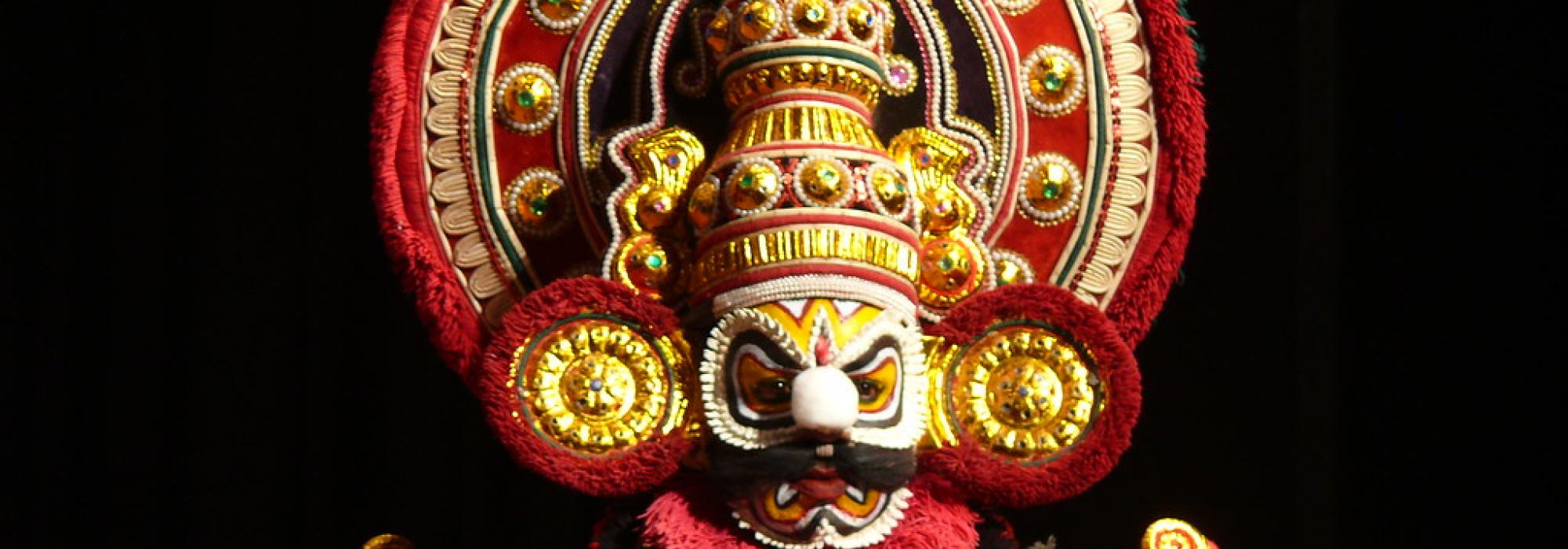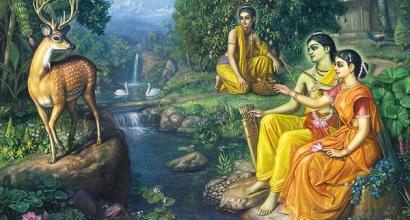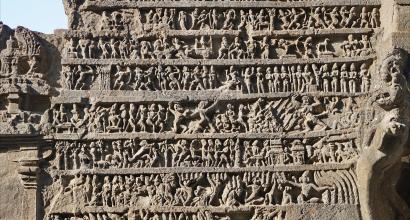Vācika
Mātu and dhātu are the two aspects of vācikābhinaya. They can be loosely translated as lyrics and music, respectively. Gadya, padya, and gīta (pada) are the components of mātu. Gāna and vādana tuned to śruti and laya constitute dhātu. We shall have a look at the vācikābhinaya of Yakṣagāna in the same order.
One of the unique features of Yakṣagāna is the extempore speech that artistes deliver on the stage while playing character roles. This, at times, is one of the strengths of Yakṣagāna and at other times, a major drawback. Freedom of speech can be misused by an artiste if he is reckless. The erudition possessed by the artiste can, at times, metamorphose into an ugly display of scholarship. Reactionary arguments can disrupt Rasa. Instead of employing words as a means of creative expression, artistes at times enter into vulgar conversations. These unaesthetic and unwarranted tendencies seem to have crept into Yakṣagāna through Tāḻa-maddaḻè . Nevertheless, we should remember that a beautiful lotus may also blossom in dirty waters – thanks to the frequent birth of such fragrant lotuses, the art of Yakṣagāna pleases its connoisseurs.
Most artistes work within the limits of the aesthetics of their character as long as they are performing abhinaya for musical rendition of pada and padya. But when they start giving free vent to their speech, they tend to go overboard and utter words that do not suit the character they are portraying. They also end up becoming advocates for their character, rather than transforming themselves into the character. They aim at shutting the mouths of the other artistes (characters) and derive great pleasure in ‘winning’ over arguments. Artistes seem to forget that they have to work hand-in-hand with all other artistes (characters) to evoke Rasa. With a combative attitude, they enter into debates on the stage. Instead of emoting the mental landscape of the character through their speech, artistes tend to show off their knowledge of the purāṇas and display their personal biases. Some of them even bring in their personal grudges and preferences on to the stage, completely disrupting the aesthetics of Yakṣagāna[1]. Rasa can only be evoked when the artiste is dispassionate about the emotion he delineates. The very purpose of art is to overcome personal likes and dislikes, selfishness and possessiveness. On the contrary, if art becomes a medium to fuel disharmony, display egos and proclaim victory and defeat, the real spirit of art is lost. If artistes become sentimentally attached to the character roles they are playing, how can they develop detachment? Rasa cannot be evoked at all.
It is true that every art needs to have an intellectual dimension and artistes need to possess erudition, for adequate evoking of Rasa. Erudition, scholarship and the intellect should not come in the way of aesthetic enjoyment and must seamlessly blend into the art.
Yakṣagāna artistes must bear in mind that the conversation that comes as a part of Tāḻa-maddaḻè is quite different from what is required for a Yakṣagāna theatre presentation. In presentations of Tāḻa-maddaḻè, the visual dimensions of āhārya and āṅgika (including mukhajābhinaya) are absent and vācika has to make good for the missing dimensions of abhinaya. In fact, sāttvika also needs to come out through vācika; though the artistes of Tāḻa-maddaḻè might have some facial expressions as they speak, they do not constitute well-trained and nuanced mukhajābhinaya required for holistic theatre. Therefore, the proportions of logic and participation of the intellect are quite different. In a Yakṣagāna performance, on the other hand, speech – both conversations and introductory segments (pīṭhikā-prastāva) – should be subservient to the character and the episode presented. They should align with āhārya and āṅgika to ultimately evoke Rasa. This understanding is called prabandhaucitya in Indian aesthetics.
~
The lyrics of the Yakṣagāna prasaṅga, i.e., the prasaṅga-pāṭhya[2], too forms an element of the vācika. It can also be considered the foundation for vācika. The prasaṅga-pāṭhya contains the story, characterizations, aspects of the five sandhis[3] and all the elements that work towards bolstering Rasa. It is endowed with structural aspects such as chandas, alaṅkāra, and language that traditionally go well with Yakṣagāna. There is a lot of variety in the themes of Yakṣagāna prasaṅgas. Dr. Padekallu Vishnu Bhat has made a list of over six thousand prasaṅgas. No other theatrical form of India possesses such abundance of literature. Of course, not all prasaṅgas are of the same quality. There are differences in the manner in which they can be brought on to stage. Some are more poetic than the others. A few can lend themselves well to music; there are others that hardly have any musicality in them. Even the best of the prasaṅgas may be filled with grammatical errors and weak metrical patterns; it may also be harsh on the ears. Some commonly observed shortcomings include pedantic language, lack of lucidity and absence of figures of speech. In addition to such structural flaws, a more important drawback in some prasaṅgas is the lack of dhvani. Sometimes, the story is not coherent and the characterization is weak. There are also prasaṅgas that do not align with the vision of the master poets such as Vyāsa and Vālmīki; such prasaṅgas wrongly portray characters and compromise on the values they represent. Some prasaṅgas are not entertaining at all. The ‘poets’ of such prasaṅgas would have paid hardly any attention to the five sandhis, avasthās[4] and arthaprakṛtis[5] that are necessary for any effective theatrical presentation. When these are absent, the presentation will certainly lack the potential to evoke Rasa. When such important elements are missing in a prasaṅga, merely adhering to structural elements such as chandas and grammatically correct language will not suffice. Bringing in colourful characters on the stage may impress the lay, but does not leave a deep aesthetic impact on the audience. Many prasaṅgas are composed in colloquial language and are wanting in beauty. They can entertain the masses but do not leave a lasting impact on the conscious connoisseurs. Such prasaṅgas can neither strike the tender chords of emotion nor suggest human values.
Many prasaṅgas based on purāṇic episodes seem to compromise on the symbolic, suggestive and metaphorical elements of the story. They seem to care little for the vision of the master poets and ignore dharma and ṛta that the stories are meant to embody. Sādhāraṇīkaraṇa is not possible if the values embedded in the story are compromised. Such presentations will not culture the connoisseur’s heart. One of the main reasons for such compromises is the lack of erudition and creative talent in the authors of the prasaṅgas. Moreover, the prasaṅgas composed in the past were influenced by mata (roughly translated as religious sect or creed) of the composer. This bias of the author got reflected in their compositions as well. Today’s composers have the tendency of tailoring their prasaṅgas to cater to social issues that are ephemeral in nature. Many have brought in unaesthetic changes in the name of ‘reformation.’ Artistes also think that didactical prasaṅgas educate the audience. Some prasaṅgas are scripted solely for the sake of ‘preaching’ the masses and awakening them to ‘societal truths.’ Back in the past, prasaṅgas harped upon religious beliefs while today’s scripts are grappling with ‘Social Justice’, at the cost of jeopardizing aesthetics. Many artistes try to communicate explicit messages regarding AIDS, hygiene, and care for the environment through their performances and thereby compromise the very purpose of classical art. There are also prasaṅgas that portray Ambā of Mahābhārata losing control over herself and Lakṣmaṇa chopping off Śūrpaṇakha's breasts. These are evidently due to lack of understanding of aesthetics of the art and the vision of the seer-poets. One could say that such prasaṅgas are plagued with ati-vācyatā-doṣa – extremely explicit and vulgar expression.
Stories from the purāṇas and itihāsas go well with the genre of Yakṣagāna. Creative interpolations and symbolic story-telling should take place in the backdrop of the purāṇas and itihāsas for the presentations to be successful. Any attempts at bringing ‘real-life stories’, can rupture the aesthetics of the art. Yakṣagāna, like any other art, is anukīrtana (exalted imitation) of life and the world. Therefore, absolute realism does not go well with Yakṣagāna.
There have been attempts at presenting Yakṣagāna in the Sanskrit and English languages as well. Poems composed by famous poets have also been employed in Yakṣagāna.
The composition of prasaṅgas can be enriched by using different metrical and rhythmic patterns. Arthālaṅkāras and śabdālaṅkāras naturally add beauty to the lyrics. Dīpaka, parikara, parikarāṅkura, samāsokti, and kāvyaliṅga are examples of a few figures of speech that can be used for the composition of padyas. Alliterations and rhyme can embellish the compositions as well. Such simple steps can help beautify compositions and make way for deep experience of Rasa. It will also enrich the vocabulary of Yakṣagāna and may help develop literature filled with dhvani. Such literature will naturally have the potential for impactful communication of profound content. A good prasaṅga can be scripted only when the composer has internalized the concepts of Rasa, dhvani, aucitya, and vakratā.
Amruta Someshwara, Hosatota Manjunatha Bhagavata, Ni. Na. Madhyastha, M A Hegade, K Divakara Hegade, Korgi Venkatesha Upadhyaya, Korgi Shankaraṇarayayana Upadhyaya, Shimanturu Narayana Shetty, and Vasanta Bharadwaja have brought in such novelty in Yakṣagāna prabandhas, as far as my knowledge goes.
Kukkila Krishna Bhat and Taltaje Keshava Bhat have identified the roots of the Yakṣagāna-prabandha in the bèdaṃḍè-gabba of Haḻagannaḍa. I have composed a few prasaṅgas keeping this background in mind. My compositions are largely meant for Ekavyakti and Yugalarūpaka presentations and is rich with Haḻagannaḍa. I request the learned connoisseurs to take a look at my compositions and asses their quality.
This series of articles is authored by Shatavadhani Dr. R Ganesh and have been rendered into English with additional material and footnotes by Arjun Bharadwaj. The article first appeared in the anthology Prekṣaṇīyaṃ, published by the Prekshaa Pratishtana in Feburary 2020.
[1] People of Dakshina Kannada seem to have natural inclination towards intellectual and analytical conversations – this has probably led to the tendency of entering into a verbal duel on the stage. This kind of combative attitude was not natural to the artistes of Uttara Kannada in the past.
[2] prasaṅga refers to the main theme and storyline of presentation and pāṭhya means literature.
[3] Mukha-sandhi, pratimukha-sandhi, garbha-sandhi, avamarśa-sandhi and nirvahaṇa-sandhi are the stages of plot development. For further reading, refer the chapter Sandhi-nirūpaṇam of the Nāṭyaśāstra
[4] Avasthās are five stages in the development of the plot from the perspective of the hero’s efforts.
[5] Arthaprakṛtis are connected with the progress of the story in a theatre presentation. For further reading, refer the chapter Sandhi-nirūpaṇam of the Nāṭyaśāstra














































